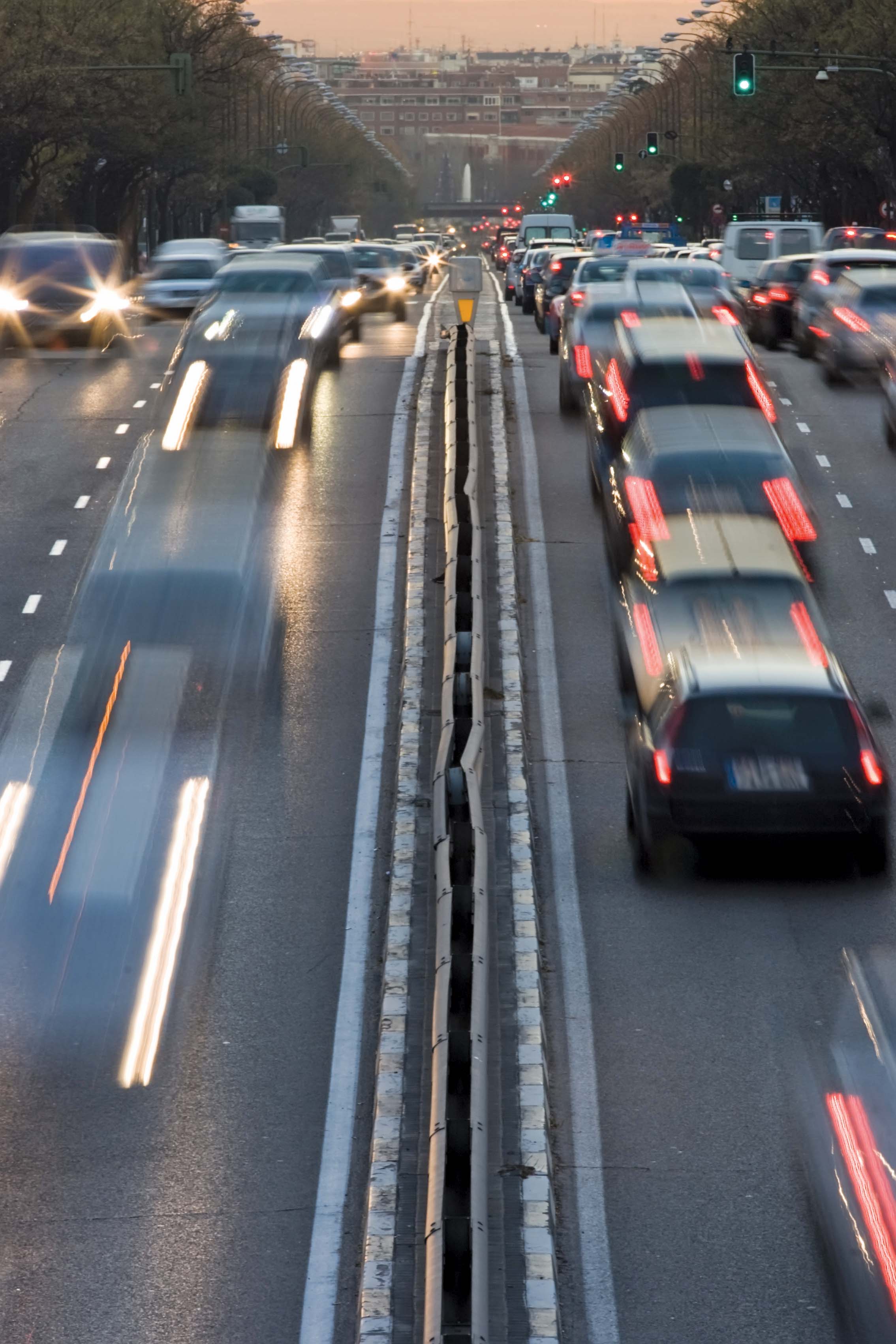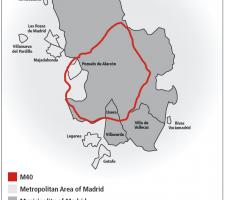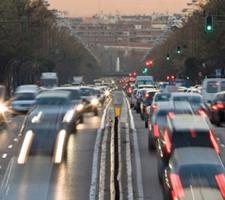
Road pricing would reduce the traffic volume on the M40 by a third but risked social exclusion for some poorer households
Road pricing can have a detrimental effect on the mobility and employment levels of low income households. Colin Sowman talks to Floridea Di Ciommo to discover why.
Since the road pricing and tolling were first introduced it has been acknowledged that such schemes could have a disproportional impact on low income households but a study in Madrid, Spain, has revealed just how regressive such measures can be. The findings revealed that the consequences of a proposed road pricing scheme would be a 17% increase in travel costs for those in poorer households while costs for those more affluent neighbourhoods would only rise by 8%.
“What is even more worrying is that our research showed such a scheme could prevent unemployed people being able to get a job outside of their immediate area because travel costs had become too high,” says lead researcher Floridea Di Ciommo. “Families could also be prevented from visiting relatives and friends for the same reason,” she adds.
The project was undertaken to determine the effect of a proposed road pricing scheme on the M40 orbital motorway around Madrid. Demand modelling was used to determine the travel demand for private car motorists during the weekday morning peak period (7-10am) on Madrid’s main road network.
The study then evaluated the impact on three neighbourhoods: Pozuelo de Alarcón in the north-west of the city represented the wealthier end of the spectrum with an average income per capita of more than €1,900. To the south of the city and ‘outside’ the M40 are the much poorer suburbs of Getafe and Leganes where the average income per capita is €880 and €940 respectively.
According to Di Ciommo, comprehensive social equity considerations are not generally well embedded in the transport decision-making process and in Europe very little attention has been paid to social equity of mainstream transport policy evaluation. “Our study reveals that when a toll or road pricing scheme is introduced it has the highest adverse impacts on accessibility in districts with very few or expensive public transport alternatives.”
Researchers found that 90% of the travel undertaken by people in the poorer neighbourhoods was classified as ‘obligatory’ - such as commuting to work, travelling to college or accompanying children to school. This left little scope for individuals to change their travel times to minimise or avoid the road pricing charge. Those in the lowest income bracket may not be able to afford the additional financial burden of road pricing as continuing to drive on the M40 would see transport costs increase to account for 12% of their monthly income.
The study found that a quarter of the poorer households would switch to using Madrid’s public transport but they would also face an increase in travel costs of between 11% and 17% and see their travel times rise by at least a factor of 1.6. In the more affluent northern suburb, only 15% of people would consider switching to public transport and the additional per capita cost would be lower at between 8% and 13%.
“This would not only increase the disadvantage suffered by lower income households, but it also highlights why there is such congestion in the first place: many travellers have few viable alternatives so they have to go on the M40. Those who ‘give up’ the tolled highway have to change their mobility strategies and find new travel arrangements. Their choice is either spend double the time for their commuter trips by switching to the public transport or to not make the trip and simply stay at home. This is highly regressive and risks encouraging social exclusion,” she says.
)Results from the study groups indicate that the effect of implementing a road pricing scheme designed to reduce traffic volumes on the M40 by 37% during the weekday peak periods, would be a modal shift of 20% from car to public transport for low income zones and 10% for high income zones.
However, respondents highlighted structural problems as those travelling between locations on the outskirts of the city are not well served by public transport as Madrid’s commuter and rail network is, as is common in many cities, laid out in a radial fashion.
Participants in study groups in the poorer southern neighbourhoods perceive price as a key decider in their selection of private or public transport. The study found that monthly transport tickets were costlier for those living in the southern districts which participants believe is as an exclusionary factor due to the poor connectivity with the centre of Madrid. A lower fare price could incentivise many of these people to choose public transport instead of the car.
Perhaps more fundamentally, participants highlighted connectivity problems inside the southern districts and that some new public transport infrastructure projects, such as MetroSur, have only solved the problem of the connectivity between districts, and even then not always very effectively. Private transport was viewed as more convenient than public in terms of travel times - especially among participants commuting into the southern districts.
Students and the unemployed were more aware of cost of public transport and fare limitations while elderly older people perceived the improvements in public transport which went unnoticed by younger travellers. Although Madrid has a scheme where students and the unemployed have a combined ticket for use at certain times, the south-east region covering the neighbourhoods in the study are excluded by the Transport Authority as not cost-effective.
Di Ciommo says Madrid’s fare system is distance based, so people living further away from the city centre in the suburbs where rents are lower have to travel further which means they pay a higher price. This is especially the case for a single ticket. While the authorities in Madrid have introduced a one hour combined travel ticket allowing interchange between urban buses inside of the city, the periphery of the metropolitan area is excluded from the measure. "This has the effect of excluding people in the poorer neighbourhoods we studied from activities in the city centre.
“Our findings bring up to date a study in 2000 of a commuter pricing scheme in Dresden [Germany] which concluded that if toll revenues are not redirected towards low-income travellers, road pricing will be regressive on poorer households. Although the economic conditions during the two studies are very different, the outcome is identical.”
Indeed economic conditions dissuaded the authorities in Madrid from implementing the road charging scheme but Di Ciommo says the implications of the study’s findings go much wider than one scheme in one city: “There is a need to develop new socio-political evaluations of transport accessibility in cities and both transport and land use planners need new and improved methods to assess the accessibility impact of transport policies.”
So what mitigating factors could an authority put in place before implementing a road charging structure to ensure the outcome is not regressive? Di Ciommo recommends implementing a single ticket policy covering all modes of public transport. “The majority of participants pointed out the lack of fare integration in Madrid as the most important to them in terms of their use of the public transport. Using different transport systems such as the metro and regional railways is much more expensive than using a single mode and fare integration is only possible with a monthly or annual ticket.”
Although the study looked at Madrid, Di Ciommo believes the findings are equally valid in many other cities in Europe and beyond: “We have shown that road pricing mainly affects low-income drivers in Madrid because the city is sprawling and job locations can be scattered in a different part of city. While the public transport is very efficient the configuration of the road network means it is very difficult for public transport to compete with cars when travel distances are large - often across the city from south to north. Our findings empirically identify the regressive nature of road pricing even in Europe where car dependency of poorer households is lower and their access to public transport is much higher than areas like North America.
“We do not say that road-pricing schemes should not be introduced, but that policy makers need to be more aware of the potentially negative social equity effects and introduce measures designed to counter the disproportionate effects on lower income individuals and households.”
Since the road pricing and tolling were first introduced it has been acknowledged that such schemes could have a disproportional impact on low income households but a study in Madrid, Spain, has revealed just how regressive such measures can be. The findings revealed that the consequences of a proposed road pricing scheme would be a 17% increase in travel costs for those in poorer households while costs for those more affluent neighbourhoods would only rise by 8%.
“What is even more worrying is that our research showed such a scheme could prevent unemployed people being able to get a job outside of their immediate area because travel costs had become too high,” says lead researcher Floridea Di Ciommo. “Families could also be prevented from visiting relatives and friends for the same reason,” she adds.
The project was undertaken to determine the effect of a proposed road pricing scheme on the M40 orbital motorway around Madrid. Demand modelling was used to determine the travel demand for private car motorists during the weekday morning peak period (7-10am) on Madrid’s main road network.
The study then evaluated the impact on three neighbourhoods: Pozuelo de Alarcón in the north-west of the city represented the wealthier end of the spectrum with an average income per capita of more than €1,900. To the south of the city and ‘outside’ the M40 are the much poorer suburbs of Getafe and Leganes where the average income per capita is €880 and €940 respectively.
According to Di Ciommo, comprehensive social equity considerations are not generally well embedded in the transport decision-making process and in Europe very little attention has been paid to social equity of mainstream transport policy evaluation. “Our study reveals that when a toll or road pricing scheme is introduced it has the highest adverse impacts on accessibility in districts with very few or expensive public transport alternatives.”
Researchers found that 90% of the travel undertaken by people in the poorer neighbourhoods was classified as ‘obligatory’ - such as commuting to work, travelling to college or accompanying children to school. This left little scope for individuals to change their travel times to minimise or avoid the road pricing charge. Those in the lowest income bracket may not be able to afford the additional financial burden of road pricing as continuing to drive on the M40 would see transport costs increase to account for 12% of their monthly income.
The study found that a quarter of the poorer households would switch to using Madrid’s public transport but they would also face an increase in travel costs of between 11% and 17% and see their travel times rise by at least a factor of 1.6. In the more affluent northern suburb, only 15% of people would consider switching to public transport and the additional per capita cost would be lower at between 8% and 13%.
“This would not only increase the disadvantage suffered by lower income households, but it also highlights why there is such congestion in the first place: many travellers have few viable alternatives so they have to go on the M40. Those who ‘give up’ the tolled highway have to change their mobility strategies and find new travel arrangements. Their choice is either spend double the time for their commuter trips by switching to the public transport or to not make the trip and simply stay at home. This is highly regressive and risks encouraging social exclusion,” she says.
)Results from the study groups indicate that the effect of implementing a road pricing scheme designed to reduce traffic volumes on the M40 by 37% during the weekday peak periods, would be a modal shift of 20% from car to public transport for low income zones and 10% for high income zones.
However, respondents highlighted structural problems as those travelling between locations on the outskirts of the city are not well served by public transport as Madrid’s commuter and rail network is, as is common in many cities, laid out in a radial fashion.
Participants in study groups in the poorer southern neighbourhoods perceive price as a key decider in their selection of private or public transport. The study found that monthly transport tickets were costlier for those living in the southern districts which participants believe is as an exclusionary factor due to the poor connectivity with the centre of Madrid. A lower fare price could incentivise many of these people to choose public transport instead of the car.
Perhaps more fundamentally, participants highlighted connectivity problems inside the southern districts and that some new public transport infrastructure projects, such as MetroSur, have only solved the problem of the connectivity between districts, and even then not always very effectively. Private transport was viewed as more convenient than public in terms of travel times - especially among participants commuting into the southern districts.
Students and the unemployed were more aware of cost of public transport and fare limitations while elderly older people perceived the improvements in public transport which went unnoticed by younger travellers. Although Madrid has a scheme where students and the unemployed have a combined ticket for use at certain times, the south-east region covering the neighbourhoods in the study are excluded by the Transport Authority as not cost-effective.
Di Ciommo says Madrid’s fare system is distance based, so people living further away from the city centre in the suburbs where rents are lower have to travel further which means they pay a higher price. This is especially the case for a single ticket. While the authorities in Madrid have introduced a one hour combined travel ticket allowing interchange between urban buses inside of the city, the periphery of the metropolitan area is excluded from the measure. "This has the effect of excluding people in the poorer neighbourhoods we studied from activities in the city centre.
“Our findings bring up to date a study in 2000 of a commuter pricing scheme in Dresden [Germany] which concluded that if toll revenues are not redirected towards low-income travellers, road pricing will be regressive on poorer households. Although the economic conditions during the two studies are very different, the outcome is identical.”
Indeed economic conditions dissuaded the authorities in Madrid from implementing the road charging scheme but Di Ciommo says the implications of the study’s findings go much wider than one scheme in one city: “There is a need to develop new socio-political evaluations of transport accessibility in cities and both transport and land use planners need new and improved methods to assess the accessibility impact of transport policies.”
So what mitigating factors could an authority put in place before implementing a road charging structure to ensure the outcome is not regressive? Di Ciommo recommends implementing a single ticket policy covering all modes of public transport. “The majority of participants pointed out the lack of fare integration in Madrid as the most important to them in terms of their use of the public transport. Using different transport systems such as the metro and regional railways is much more expensive than using a single mode and fare integration is only possible with a monthly or annual ticket.”
Although the study looked at Madrid, Di Ciommo believes the findings are equally valid in many other cities in Europe and beyond: “We have shown that road pricing mainly affects low-income drivers in Madrid because the city is sprawling and job locations can be scattered in a different part of city. While the public transport is very efficient the configuration of the road network means it is very difficult for public transport to compete with cars when travel distances are large - often across the city from south to north. Our findings empirically identify the regressive nature of road pricing even in Europe where car dependency of poorer households is lower and their access to public transport is much higher than areas like North America.
“We do not say that road-pricing schemes should not be introduced, but that policy makers need to be more aware of the potentially negative social equity effects and introduce measures designed to counter the disproportionate effects on lower income individuals and households.”
| Southern Districts | Monthy income per captia ( € ) | Income Burden Variation (%) | Northern Districts | Monthy income per captia ( € ) | Income Burden Variation (%) |
|---|---|---|---|---|---|
| Villa de Vallecas | 944 | 11% | Pozuelo de Alarcon | 1903 | 8% |
| Getafe | 943 | 17% | Las Rozas de Madrid | 1719 | 9% |
| Villaverde | 830 | 13% | Majadahonda | 1696 | 9% |
| Rivas Vaxiamadrid | 1187 | 17% | Villanueva del | 1251 | 13% |
| Leganes | 880 | 17% | Torrelodones | 1646 | 9% |













